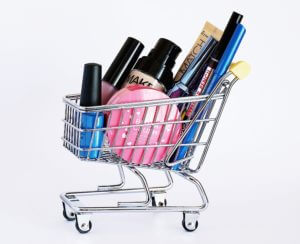(And it’s Certainly Not the Only One…)
A new study reported in June 2021 leaves no doubt…
Researchers at the University of Notre Dame conducted testing using advanced technology on 231 commonly used cosmetics and makeup products.
These products included those from some big name brands, including Ulta Beauty, Sephora, and Bed Bath & Beyond. All were purchased in the U.S. and Canada.
And what researchers found was shocking.
According to findings published in the journal Environmental and Science Technology Letters, testing revealed that high levels of the toxin fluorine (scientists call it PFAS or per- and polyfluoroalkyl substances) were found in: 
- 58% of eye care products
- 63% of foundations
- 55% of lip products
- 47% of mascaras
Of course, PFAS are not only found in cosmetics and personal care products. They are used in everything from nonstick cookware to carpets to coated fabrics.
So it’s really no wonder that a 2015 government study found that almost 97% of Americans had PFAS in their blood.
PFAS have been called “forever chemicals” since they don’t break down in the environment.
Dangers of PFAS Suppressed by the Government
Reporters from ProPublica claim that, in 2018, an 852-page report from the U.S. Centers for Disease Control and Prevention (CDC) about health dangers of PFAS was suppressed because it was a “public relations nightmare.”
This report from the CDC, which was not widely available to the general public, detailed known human health risks of PFAS, which include:
- Cancer
- Decreased fertility
- Liver damage
- Increased risk of asthma
- Increased risk of thyroid disease
A 2020 Danish study reported in the journal PLOS One also linked PFAS exposure to more severe COVID-19 outcomes.
Harvard Had Warned of PFAS Health Risks Years Earlier
While this 2021 study from Notre Dame is frightening, several years ago, the Harvard T.H. Chan School of Public Health had already noted that PFAS may pose much greater health risks than had been previously thought.
Elsie Sunderland, a professor in the Department of Environmental Health at Harvard’s School of Public Health, warned that scientists are only just now starting to understand the negative effects of over 4,000 different types of PFAS chemicals. She reports that the chemical industry often uses new PFAS compounds to replace old ones, a process commonly called “chemical whack-a-mole.”
You might wonder why manufacturers add this fluorine toxin to cosmetics. Well, according to the Notre Dame study, it happens for several reasons: 
- It increases their durability, product wear, spreadability, and water resistance (particularly high fluorine levels were found in products advertised as “wear-resistant” or “long-lasting”)
- It increases skin penetration and absorption of the product (definitely not a good thing when it comes to your health)
- It shows improvement in the texture or appearance of skin (temporarily, but at what cost?)
Lax Labeling of PFAS
Another important finding in this recent study was that only 8% of the 231 cosmetics tested for total fluorine had any PFAS listed as ingredients. Without legal requirements for honest labeling, consumers will find it nearly impossible to avoid exposure to PFAS in the products they purchase.
The study also pointed out the lax regulatory requirements in the U.S. and Canada when it comes to reporting PFAS use (this goes for many chemicals used in cosmetics).
While cosmetics may not use that specific term, you may find fluorine/PFAS on ingredient labels under names such as:
- PTFE
- Perfluoro
- Methicone and dimethicone
- Acrylate and methacrylate
- Silicone
- And many others, including coloring ingredients such as HC Yellow No 13
The Notre Dame study concluded with a plea for better labeling and government oversight of harmful chemicals in personal care products.
New Laws Coming?
Perhaps some people were listening…
As reported in the Boston Globe, in June 2021, a bipartisan effort was started by senators Susan Collins, a Maine Republican, and Richard Blumenthal, a Connecticut Democrat. They brought forth the ‘No PFAS in Cosmetics Act.’ Senator Collins stated: “Our bill would require the FDA to ban the addition of PFAS to cosmetics products. Americans should be able to trust that the products they are applying to their hair or skin are safe.”
This may be a good start, but unfortunately, PFAS are only one of many toxins found in cosmetic products.
Many Dangerous Toxins in Cosmetics
According to the Environmental Working Group, just since 2009… 
Nearly 600 cosmetics manufacturers have reported using 88 chemicals, in more than 73,000 products — products linked to cancer, birth defects or reproductive harm.
In addition to PFAS, here are some of the most harmful chemicals to avoid (check products labels closely for any of these).
They are known collectively as “the dirty dozen.”
- Parabens
As noted by the Environmental Working Group, these chemicals are commonly used as artificial preservatives in body care and cosmetic products. This means they lengthen the product’s shelf life. Studies suggest that paraben chemicals can act as hormone disruptors, increase cancer risk, and harm reproductive organs. While not as serious an effect, they may also irritate skin. Check labels for any ingredient containing the word paraben. For example, methylparaben or ethylparaben. - Triclosan
Triclosan is an antimicrobial agent found in cosmetics, soaps, deodorants, and many other products. Unfortunately, research has shown that triclosan can disrupt hormones of the thyroid and sex organs. In addition, it can accumulate in fatty tissues. It is found in human breast milk, raising worries of abnormal fetal development.Another concern of the Campaign for Safe Cosmetics is that triclosan may promote the growth of bacteria resistant to both triclosan and possibly antibiotics. - Sodium laureth sulfate (SLS)This chemical is used in cosmetics, shampoos, facial cleansers, and shower gels, among other things. It acts as a foam-producing surfactant. Unfortunately, during manufacturing, it is often measurably contaminated by known carcinogens called ethylene oxide and 1,4-dioxane. Look for it on ingredient labels and avoid any product containing this toxin.
- SiloxanesThese chemicals are derived from silicone, and used in cosmetics and hair products to smooth out, moisturize, and soften skin. Silicon is found in minerals used in certain products, including clay, mica, and others. The EU has classified some siloxanes as endocrine disruptors and carcinogens. They may also harm the reproductive, immune, and nervous system.
- PetrolatumPetrolatum (petroleum jelly) is derived from petroleum, and used in personal care products as a moisturizing agent. When properly refined, petrolatum has no known health concerns. However, according to the Campaign for Safe Cosmetics, petrolatum is often not properly refined in the United States. This means it may be contaminated with toxic chemicals called polycyclic aromatic hydrocarbons (PAHs), which have been linked to cancers, particularly breast cancer. PB HERE Check labels for petrolatum, petroleum jelly, mineral oil, and paraffin oil.
- PEG compounds (polyethylene glycols)These chemicals are petroleum-based chemicals used in cosmetics as softeners, moisturizers, and thickeners. They are often used as cosmetic cream bases and penetration enhancers. Similar to SLS, manufacturing processes may contaminate them with ethylene oxide and 1,4-dioxane, known carcinogens.
- Parfum (fragrance)Cosmetics and body care products often list “fragrance” on the label, but usually fail to name the ingredients involved. The International Fragrance Association lists over 3,000 ingredients reported as fragrance compounds, and some have been linked to allergies, sensitivities, cancer, reproductive issues, and many other health issues. Pregnant women are particularly vulnerable. PB HERE Check labels for words such as perfume, parfum, fragrance, essential oil blend, and aroma.
- Formaldehyde-releasing preservatives (FRPs)FRPs are used in a number of personal care products, including cosmetics, hair gels, nail polish, and others. They help prevent microbial development in products. Formaldehyde is a known human carcinogen, so it is best to avoid any product containing these chemicals.Unfortunately, they often go by long technical-sounding ingredient names such as quaternium-15, DMDM hydantoin, and polyoxymethylene urea, just to name a few. This makes it extremely difficult to determine whether FRPs are present. However, when you see any terms like these, as a general rule, you can assume there are potentially hazardous chemicals in that product.
- BHA and BHT BHA (butylated hydroxyanisole) and BHT (butylated hydroxytoluene) are synthetic antioxidants used as preservatives in cosmetics such as lipsticks and moisturizers. BHA has been listed as a possible human carcinogen and endocrine disruptor. Animal studies have shown that BHT can promote tumor growth, and may cause liver, kidney, thyroid, and lung issues.
- Coal tar dyes You may not realize it, but coal tar dyes or colors are present in nearly all cosmetics. You will find them in many hair dyes. Coal tar is a known human carcinogen. They may be derived directly from coal tar or produced synthetically. Just look for the letters ‘CI’ followed by a series of numbers in the product ingredient list.
- Dibultyl phthalate (DBP) Phthalates are often used as fragrance ingredients and in nail products. Since DBP is absorbed by the skin, it can enhance the ability of other chemicals to cause genetic mutations. It is also a suspected endocrine disruptor and may lead to developmental defects and reproductive issues.
- DEA-related ingredients These compounds are used in cosmetics to make them sudsy or creamy. They are frequently found in moisturizers, cleansers, soaps, and sunscreens. They can not only cause skin and eye irritation, but studies have found a link to liver cancer and precancerous changes in the thyroid and skin.
How to Protect Yourself From Toxic Ingredients in Your Cosmetics
Many people fail to consider the importance of skin when it comes to overall health.
The skin is our largest organ and a primary center of our immune system.
And you may not have thought of it like this…
But just like you feed yourself through your mouth, your skin actually eats!
As you saw earlier, one reason cosmetic companies add certain chemicals to their products is be cause it increases the ease with which those toxins can penetrate the skin.
cause it increases the ease with which those toxins can penetrate the skin.
In other words, your skin has an easier time gobbling them up.
And just like eating “fast foods,” eventually this will catch up to you when it comes to negative health effects and even early aging.
That’s why it’s so important to stop feeding your skin toxic chemicals and personal care products.
In fact, when you become proactive in this way, you may notice the disappearance of some of those “mystery symptoms” such as lack of energy, digestive ills, sinus issues, and others.
And you’ve also seen some of the serious consequences of toxins found in common cosmetics: cancer, reproductive issues, thyroid disease, and more.
Of course, you should check labels for those chemicals discussed earlier.
But the #1 way to stop those toxins from getting in is to make sure you only use cosmetics and personal care products that are truly USDA Certified Organic.
This ensures:
- No toxic ingredients
- No GMOs
- No herbicides or pesticides
- No dyes, hydrogenation, or palm oil
- Independently verified
Also, beware of “greenwashing.” Many products tout themselves as being “natural” or “organic.” Lax regulations may allow manufacturers to say this when they contain only a single organic ingredient amidst many toxic ingredients. Again, check labels closely for these “faux” organic products.
Bottom line? If the product has not been independently certified organic — meaning, in the U.S., it is USDA Certified Organic — there is likely a reason why.
Don’t Settle for Toxic Products When You Can Enjoy an Independently Certified Safe and Effective Cream Designed to Fight Back Against the Visible Signs of Aging 
Find out more information about Purity Woods’ USDA Certified Organic Age-Defying Cream here.
Unlike most products on the market, all Purity Woods products are USDA Certified Organic.
The bestselling Age-Defying Dream Cream contains over 25 of nature’s most potent ingredients for your youngest-looking skin.
This includes the revolutionary maple leaf extracts likened to a “plant-based Botox” for how quickly and how well they lift, firm, brighten, and tighten your skin’s appearance.
The Age-Defying Dream Cream also “feeds” your skin three of nature’s top vitamin-C ingredients to support the collagen production that gives skin a healthful “plump” and youthful look.


